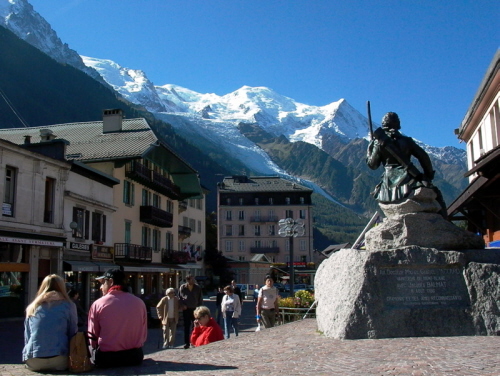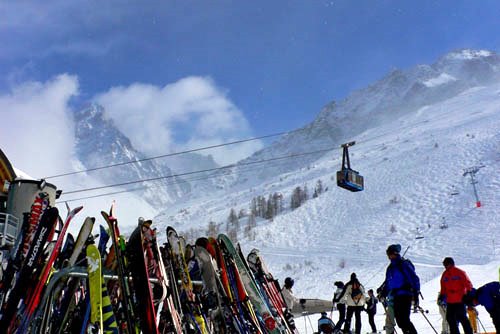

 |
The Seventh International Conference on ICDT 2012 April 29 - May 4, 2012 - Chamonix / Mont Blanc, France |
|
 |
 |
 |
| Call for Papers |
The Seventh International Conference on Digital Telecommunications (ICDT 2012) initiates a series of special events focusing on telecommunications aspects in multimedia environments. The scope of the conference is to focus on the lower layers of systems interaction and identify the technical challenges and the most recent achievements.
The conference will serve as a forum for researchers from both the academia and the industry, professionals, and practitioners to present and discuss the current state-of-the art in research and best practices as well as future trends and needs (both in research and practices) in the areas of multimedia telecommunications, signal processing in telecommunications, data processing, audio transmission and reception systems, voice over packet networks, video, conferencing, telephony, as well as image producing, sending, and mining, speech producing and processing, IP/Mobile TV, Multicast/Broadcast Triple-Quadruple-play, content production and distribution, multimedia protocols, H-series towards SIP, and control and management of multimedia telecommunications.
High quality software is not an accident; it is constructed via a systematic plan that demands familiarity with analytical techniques, architectural design methodologies, implementation polices, and testing techniques. Software architecture plays an important role in the development of today’s complex software systems. Furthermore, our ability to model and reason about the architectural properties of a system built from existing components is of great concern to modern system developers.
Performance, scalability and suitability to specific domains raise the challenging efforts for gathering special requirements, capture temporal constraints, and implement service-oriented requirements. The complexity of the systems requires an early stage adoption of advanced paradigms for adaptive and self-adaptive features.
On online monitoring applications, in which continuous queries operate in near real-time over rapid and unbounded "streams" of data such as telephone call records, sensor readings, web usage logs, network packet traces, are fundamentally different from traditional data management.
The difference is induced by the fact that in applications such as network monitoring, telecommunications data management, manufacturing, sensor networks, and others, data takes the form of continuous data streams rather than finite stored data sets. As a result, clients require long-running continuous queries as opposed to one-time queries. These requirements lead to reconsider data management and processing of complex and numerous continuous queries over data streams, as current database systems and data processing methods are nit suitable.
Event stream processing is a new paradigm of computing that supports the processing of multiple streams of event data with the goal of identifying the meaningful events within those streams.
The conference has the following specialized events:
SIGNAL: Signal processing in telecommunications
DATA: Data processing
AUDIO: Audio transmission and reception systems
VOICE: Voice over packet networks
VIDEO: Video, conferencing, telephony
IMAGE: Image producing, sending, and mining
SPEECH: Speech producing and processing
IPTV: IP/Mobile TV
MULTI: Multicast/Broadcast Triple-Quadruple-play
CONTENT: Production, distribution
HXSIP: H-series towards SIP
MULTE: Multimedia Telecommunications
MOBILE: Mobile technologies
MEDMAN: Control and management of multimedia telecommunications
SARP: Software architecture research and practice
STREAM: Data stream processing
TRACK: Tracking computing technologies
We solicit both academic, research, and industrial contributions. We welcome technical papers presenting research and practical results, position papers addressing the pros and cons of specific proposals, such as those being discussed in the standard fora or in industry consortia, survey papers addressing the key problems and solutions on any of the above topics short papers on work in progress, and panel proposals.
Industrial presentations are not subject to the format and content constraints of regular submissions. We expect short and long presentations that express industrial position and status.
Tutorials on specific related topics and panels on challenging areas are encouraged.
The topics suggested by the conference can be discussed in term of concepts, state of the art, research, standards, implementations, running experiments, applications, and industrial case studies. Authors are invited to submit complete unpublished papers, which are not under review in any other conference or journal in the following, but not limited to, topic areas.
All topics and submission formats are open to both research and industry contributions.
SIGNAL: Signal processing in telecommunications
Signal processing theory and practice
Image and multidimensional signal processing
Signal filter design and structures
Multirate filtering, filter banks, and adaptive filters
Fast signal processing algorithms
Nonlinear signals and systems
Nonuniform transformation
2D nonuniform DFT
Fast algorithm of NDFT
Advanced image/video coding
Advanced prediction techniques
Signal detection and reconstruction
Spectral estimation and time-frequency analysis
Higher order spectrum analysis
Parameter estimation
Array signal processing
Statistical signal analysis
Signal and system modeling
Cyclostationary signal analysis
Active noise control, active noise reduction and echo cancellation
Psychoacoustics and room acoustics
Signal processing for music
Binaural systems and multidimensional signal systems
Geophysical and seismic signal processing
Nonlinear interpolation/resampling
Extensions to wavelet based coding (x-lets)
Low complexity image/video compression
Multiple resolution signal processing
New approach to digital signal processing
Compression of random data
Recompression of compressed data
2D projection of 3D data
Stereo data matching
Emerging applications requiring new compression tools
Unified compression and recognition
H.264 and latest video coding standards
Latest audio coding standards
AUDIO:
Audio transmission and reception systems and devices
Digital audio transmission signal processing
Audio transmission over Internet
Audio Multiplexing Transmission Systems
Stereo audio transmission signal
Digital infrared audio transmission
Multi-stream and multi-path audio transmission
Wireless-compressed digital audio transmission
Perceptual coding for audio transmission and storage
Laser audio transmission
Synchronizing video and audio transmission
Wide-band audio transmission
Index-frame audio transmission
Digital audio transmission rights
Noise in wireless audio transmission
Audio tools and products
Standards
DATA:
Data transmission and reception mechanisms and techniques
Enhanced tools for video data integrity
Data mining, filtering, and reporting
Secure data transmission
Transmission media and data encoding
Text reading devices (super-pen, pen-elite, reading-pen)
Scanned and generated lossy (progressive) multi-page text
(Visually) lossless mechanisms
Pricing data transmission
Differential data transmission systems
Data transmission equipments and transmission rates
Delay-constrained data transmission
Undersea and satellite data transmission techniques
Performance evaluation of data transmission
Multicast data transmission
High speed data transmission
Data transmission control
Integrity and privacy in data transmission
Data transmission standards
VOICE:
Planning and implementing voice networks and systems
Voice transmission systems
Voice transmission performance
Quality real-time voice transmission
Metrics for quality of voice transmission
Stereophonic voice transmission systems
Header Compression for VoIP over WLAN
Voice over IP solution for mobile radio interoperability
VoIP over cable TV networks
VoIP over Wi-Max
WiFi and cellular dual mode phones and services
Voice over WLANs and Wi-Fi to cellular roaming
Voice transmission via the Internet
Wi-Fi voice transmission
Bluetooth-based Ad-Hoc networks for voice transmission
Standards for voice processing and transmission
VIDEO: Conferencing/telephony
Digital video
Video coding formats (ITU-T, SMPTE 421M, AVS-China)
Video coders and decoders
Profiles, latency, intermediate formats
Video surveillance and privacy
Video feature requirements
Network video recorders
Graceful degradation of archive video
Video data integrity (error detection, tamper resistance)
Alarm events for voice content (motion detection, object tracking, face recognitions)
Coding efficiency and distributed video coding
Compression and scrambling
Enhanced tools for video data integrity
Multiple reference pictures
Intra-layer and inter-layer prediction
Fading prediction and loop filter
Video with compression errors
Viewing distance and perceptual quality
Video quality models
Omnidirectional video
3D video
Video standardization encoding
Texture synthesizer
IMAGE: Image producing, transmission and management
Model-based progressive image transmission
Wireless image transmission
Computer generated images
Image security, scrambling, and regions of interest
Timing requirements for image transmission
Transmission of still and moving images
Protocols for low bit rate
Error-prone image transmission
Energy efficient image transmission
Multi-technology image formation
Devices for image capturing and processing (cams, web-cams, etc.)
Scanning and sampling, quantization and halftoning, color reproduction
Image representation and rendering, display and printing systems
Image quality assessment
Image search and sorting, video indexing and editing
Integration of images and video with other media,
Image authentication and watermarking
Image storage, retrieval and multimedia
Image and video databases
Generic coding of moving pictures
Media stream packetization
Modes for archival playback
Image-based applications
Standard for image processing
Image analysis and segmentation
Image filtering, restoration and enhancement
Image representation and modeling
Pattern recognition
SPEECH:
Tooling, Architectures, Components and Standards
Voice modulation, frequencies
Linguistics, Phonology and Phonetics
Discourse and Dialogue
Speech analysis, synthesis, coding, and recognition
Speech enhancement and noise reduction
Speech features, production, and perception
Speech Coding and Transmission
Speech Signal Processing
Spoken Language Generation and Synthesis
Speech QoS Enhancement
Speaker Characterization and Recognition
Spoken Language Resources and Annotation
Spoken/Multi-modal Dialogue Technology and Systems
Spoken Language Information Extraction/Retrieval
Speech Transmission Technology for the Aged and Disabled
Audio-Visual Speech Processing
Biomedical Applications of Speech Analysis
Spoken document retrieval
Speech Processing in a Packet Network Environment
Automatic Speech Recognition in the Context of Mobile Communications
Human Factors in Speech and Communication Systems
Automatic speech recognition and understanding technology
Speech to text systems
Spoken dialog systems
Multilingual language processing
New Applications of Spoken Language Technology and Systems
IPTV: IP/Mobile TV
IPTV applications and middleware
On-demand television
Interactive TV
Broadcast TV data
Broadcast content formats
Stereo and 3D TV
TVoDSL
Television archiving
IPTV broadcasting
IPTV-aware devices
IPTV regulatory issues and copyrights
IPTV network infrastructure
IPTV monitoring and management
I[P]TV usage fees
IPTV Personalization and QoS Implications
MULTI: Multicast/Broadcast Triple-Quadruple-play
Scalable video/audio coding
Multiplexing video/audio/data
Multimedia terminals
Multimedia systems and protocols
PSTN modems and interfaces
Facsimile terminals
Direct broadcast satellite
Terrestrial broadcast television
Cable modems
Universal media access
Format compatibility
Media support platforms
VoIP Quality for Triple Play
Testing triple-play services
Triple-play data encryption
Triple-play services
CONTENT: Production, distribution
Content injection, cashing, storage, and distribution
Producing and transmitting streaming content
Content localization services
Content and customers profiles
Documenting and content authoring
Authorizing topic-based content
Content customization and metadata
On-demand content
Content retrieval from archives (alarm-based, time stamp-based)
Content management solutions and systems
Unstructured content environment
Multi-channel content delivery/publishing strategies
Content reuse
HXSIP: H-series towards SIP
SIP and H-xxx architectures and logical components
Instant messages and presence
Management of QoS in SIP and H-xxx environments
Basic SIP building blocks
Security and firewalls with SIP and H-xxx series
Service creation and telephony services with SIP and H-xxx
Multimedia conferencing with SIP and H-xxx
SIP application scenarios
SIP (auto)configuration
SIP and H-xxx beyond VoIP
Leveraging SIP for Global Enterprise Roaming
SIP, H-xxx and 3GPP
Emergency Calling in SIP and H-xxx
Advanced SIP and H-xxx applications and services
SIP and H-xxx on Cable Networks
SIP and H-xxx devices
SIP and h-xxx deployment experience
End-to-end SIP and H-xxx communications
SIP/H.323 Interworking Function for real time communications
MULTE: Multimedia telecommunications
Frameworks, architectures, systems for delivering voices, audio, and data
Methodologies, technologies, procedures and mechanisms
IMT-2000 concepts
IMS concepts (IP Multimedia Systems)
Bluetooth and WLAN coexistence on handsets
Packet-based multimedia communication systems
Converging technology for voice and data networks
Accessibility features for unpaired users
Confidentiality for audiovisual services
Multimedia transmission performance
Multiplexing and synchronization
Directory services for multimedia
Computation complexity and costs (multiple simultaneous decoders)
Coding efficiency (embedded, bit-plane, arithmetic)
Compatibility between Analog/DVD and networks
IP4/IP6 transition and NAT
QoS/SLA, perceptual QoS, and formal visual tests
Temporal and spatial scalability
Pre-processing and predictive coding
Coding with regions-of-interest
Secure transcoding
Computation power and resolution
Transform and quantization
Entropy coding
Lossless and lossy compression
Transmission in noisy environments
Voice/video/data in 4G
Specialized medical applications
Medical imaging and communications networks
MPEG for endoscopy, microscopy, radiology, surgery
Medical archiving systems
Digital devices for image capturing (microscope, stethoscope)
Digital equipments and digital cinema
Digital signature protection
MOBILE: Mobile technologies
3G+: UMTS, HSPA, HSUPA, HSDPA, HSOPA, WiMAX, UWB. LTE, All-IP LTE 4G and beyond
Seamless handover engineering
Cognitive radio
Mobile video surveillance
Pervasive/ubiquitous/mobile systems
Security and privacy issues for mobile and wireless systems
Mobile ad hoc networks
MEDMAN: Control and management of multimedia telecommunications
Video codec-aware of packets
Monitoring via guard on patrol, central station, forensic analysis
Managing single domestic licensing and granted patent pool for compressions
End-to-end quality monitoring/management
Perceived/offered quality: video-only, audio-only, audio-video
In-service monitoring of voice/video/data services
Real-time distributed imagery management systems
Performance in voice/video/data systems
Distributed multimedia service management
Mobile multimedia network management
Multi-point, multicast services management
Deployment of multimedia services
Network management models and architectures
Billing and security for multimedia services
Network measurement/monitoring for multimedia services
SARP: Software architecture research and practice
Distributed software architecture
Architectural styles and patterns
Architecture refinement and transformation
Software architecture and pervasive systems
Software architecture analysis & testing
Architectural description languages (ADLs)
Component-based software architecture
Dynamic software architecture
Self-repairing software architecture
Adaptive software architecture
Aspect-oriented software architecture
Service-oriented architecture [SOA]
Domain specific software architecture [DSSA]
Tools/Environments for software architects
Product-line software architecture
Industrial case studies and reports
STREAM: Data stream processing
Fundamentals on data stream processing
Data stream processing and event stream processing
Continuous query languages
Time management in data stream systems
Aggregated queries support
Query processing with multiple, continuous, rapid, time-varying data streams
Processing frequent itemset discovery queries
Real-time stream data processing
Network-aware operator placement for stream-processing systems
Integrating database queries and Web searches
Scalable Distributed Stream Processing
Optimization of data stream processing
Performance and overhead in data stream processing
QoS adaptation in data stream systems
Adaptive query processing in data stream
Interactive distributed data stream processing and mining
Data stream management systems
Control theory on stream processing
Processing high-speed data streams
Stream processing in production-to-business software
Multi-site cooperative data stream analysis
Grid-based data stream processing
Hyperdatabases for P2P data stream processing
Sensor data stream processing in health monitoring
Processing and sharing data streams in Grid-based P2P infrastructures
TRACK:Tracking computing technologies
Airport security communications technologies
Hazards detection- automatic real-time material/object recognition
Intelligent IP-based sensor networking for homeland security
Real-time intelligence data validation and verification mechanisms
Efficient data integration and mining techniques for NATO countries
Secure distributed storage and data pinning
SATCOM for HLS
Critical aerospace communications systems
HLS for air, land and sea operational environments
Airborne real-time spatial tracking techniques
Bio-authentication sensors and tools
Cyber and physical security of key infrastructure and operations
Protection of Real-time resilient communications network infrastructures
International standards for data schema and data sharing between USA and other countries
Emergency response tools
Prediction of Intent
Standards for Passenger Data Integration
Sharing Addressing and Service Discovery in Auto-configuring MANETs
Exploiting localization and network information (GPS, INS, GIS, terrain features, ToA, AoA, SNR, QoS) for improved ad-hoc networking in complex terrain
Advanced indoor and outdoor location-based applications: real-time tracking, multimedia, bidirectional, proactive applications
Location based services based on integrated cellular, ad hoc, RFID, and sensor networks
New positioning techniques in support of location based servcies (indoor, cellular, satellite, hybrid)
Geographic Information Systems for supporting location based services
Quality of location data
Integration of Hierarchical Location-Based Routing (HLBR) with Delay- and Disruption-Tolerant Neworks (DTNs)
Narrow-band control channels for HLBR
Location-aware (GPS-aware) Internet Browsers for Location-based services
INSTRUCTION FOR THE AUTHORS
Authors of selected papers will be invited to submit extended versions to one of the IARIA Journals.
Publisher: XPS (Xpert Publishing Services)
Archived: ThinkMindTM Digital Library (free access)
Prints available at Curran Associates, Inc.
Articles will be submitted to appropriate indexes.
Important deadlines:
Considering the upcoming holidays, submission deadline is extended to: December 27, 2011| Submission (full paper) | |
| Notification | January 23, 2012 |
| Registration | February 7, 2012 |
| Camera ready | February 7, 2012 |
Only .pdf or .doc files will be accepted for paper submission. All received submissions will be acknowledged via an automated system.
Regular Papers (up to 6-10 page article)
Final author manuscripts will be 8.5" x 11", not exceeding 6 pages; max 4 extra pages allowed at additional cost. The formatting instructions can be found on the Instructions page. Helpful information for paper formatting can be found on the here.
Your paper should also comply with the additional editorial rules.
Once you receive the notification of paper acceptance, you will be provided by the publisher an online author kit with all the steps an author needs to follow to submit the final version. The author kits URL will be included in the letter of acceptance.
Work in Progress (short paper up to 4 pages long)
Work-in-progress contributions are welcome. Please submit the contributions following the instructions for the regular submissions using the "Submit a Paper" button and selecting the contribution type as work in progress. Authors should submit a four-page (maximum) text manuscript in IEEE double-column format including the authors' names, affiliations, email contacts. Contributors must follow the conference deadlines, describing early research and novel skeleton ideas in the areas of the conference topics. The work will be published in the conference proceedings.
For more details, see the Work in Progress explanation page
Posters (poster or collection of 6 to 8 slides, including industrial presentations)
Posters are intended for ongoing research projects, concrete realizations, or industrial applications/projects presentations. Acceptance will be decided based on a 1-2 page abstract and/or 6-8 .pdf slide deck submitted through the conference submission website. The poster may be presented during sessions reserved for posters, or mixed with presentation of articles of similar topic. The slides must have comprehensive comments. One big Poster and/or the associated slides should be used for discussions, once on the conference site.
For more details, see the Posters explanation page.
Ideas (2 page proposal of novel idea)
This category is dedicated to new ideas in their early stage. Contributions might refer to PhD dissertation, testing new approaches, provocative and innovative ideas, out-of-the-box, and out-of-the-book thinking, etc. Acceptance will be decided based on a maximum 2 page submission through the conference submission website. The contributions for Ideas will be presented in special sessions, where more debate is intended. The Idea contribution must be comprehensive, focused, very well supported (details might miss, obviously). A 6-8 slide deck should be used for discussions, once on the conference site.
For more details, see the Ideas explanation page.
Technical marketing/business/positioning presentations
The conference initiates a series of business, technical marketing, and positioning presentations on the same topics. Speakers must submit a 10-12 slide deck presentations with substantial notes accompanying the slides, in the .ppt format (.pdf-ed). The slide deck will not be published in the conference’s CD Proceedings. Presentations' slide decks will be posted on the IARIA's site. Please send your presentations to petre@iaria.org.
Tutorials
Tutorials provide overviews of current high interest topics. Proposals should be for three hour tutorials. Proposals must contain the title, the summary of the content, and the biography of the presenter(s). The tutorials' slide decks will be posted on the IARIA's site. Please send your proposals to petre@iaria.org
Panel proposals
The organizers encourage scientists and industry leaders to organize dedicated panels dealing with controversial and challenging topics and paradigms. Panel moderators are asked to identify their guests and manage that their appropriate talk supports timely reach our deadlines. Moderators must specifically submit an official proposal, indicating their background, panelist names, their affiliation, the topic of the panel, as well as short biographies. The panel's slide deck will be posted on the IARIA's site.
For more information, petre@iaria.org
Workshop proposals
We welcome workshop proposals on issues complementary to the topics of this conference. Your requests should be forwarded to petre@iaria.org.